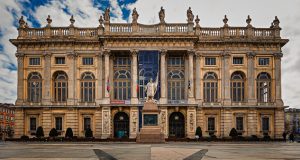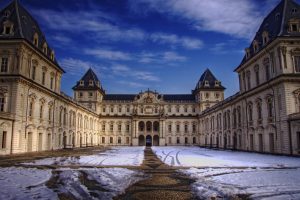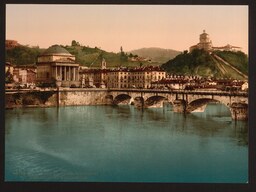ITALY - HISTORY, ART, CULTURE-bilingual almanac
Торино е четвъртият по големина град в Италия, но третият по икономическа мощ. Разположен е в северозападната част на страната и е важен промишлен център, както и столица на региона Пиемонтe. Въпреки славата си на индустриален център на Италия през 20-ти век, Торино всъщност е един елегантен и очарователен град, с широки булеварди и площади, обградени от красиви сгради. Много преди да стане дом на „Фиат“ и „Ланча“, Торино е седалище на династията Савой, които са решени да направят своята столица съперник на Париж и Виена. Това води и до невероятното бароково архитектурно наследство, с което Торино може да се похвали.
Torino is the fourth largest city d' Italia ma la terza come potenza economica. The situation in the north-western part of the country Torino is an important industrial center and capital of the Piemonte region. Nonostante la sua fama di cuore economico d'Italia nel corso del XX secolo. Torino in effect è un'elegant and fascinating città dotata di ampi viali e di piazze circondate da splendidi edifici. Molto prima di diventare la sede della Fiat e Lancia, Torino era dimora dei Savoia che they had the ambition to transform the city into a capital at the height of Paris and Vienna. Perciò oggi Torino si vanta di un incredibile patrimonio architettonico baroque.
Turin was established in Roman times and the impressive gate from the time of Emperor Augustus is one of the tourist attractions. After the French occupation at the time of Napoleon, Turin became the center of the movement for the national liberation and unification of Italy (a period known as the Renaissance). Today, the city abounds with a variety of sights and cultural monuments that remind of ancient times.
Torino è stata fodata in epoca romana e l'imponente Porta Palatina dai tempi dell'Imperatore Augusto is one of the tourist attractions della città. Dopo l'occupazione francese di Napoleone, Torino diventa il cuore del movimento di liberazione nazionale e l'unificazione d'Italia (period connoisseur come il Risorgimento). Oggi la città è colma di diversi types of attractions and monuments that are remembered i tempi antichi
THE SIGHTS OF TURIN – DA VEDERE A TORINO
PLAZA"KACBODY' – one of the main squares in Turin. There are many museums, theaters, restaurants and cafes here. The square is the historical and political center of Turin. It is here that the Royal Palace of Turin is located. The Madama Palace is also located on Castello Square.
LA PIAZZA CASTELLO – è una delle piazze principali di Torino. There are many museums, theaters, restaurants and cafes. The piazza di forma quadrata is the historical and political center of Turin. Proprio qui si trova il Palazzo Reale. Palazzo Madama is also located in Piazza Castello.
THE ROYAL PALACE – the palace is owned by the Savoy dynasty. Occupying almost one side of Piazza Castello in the city centre, the 17th-century building looks relatively plain – but only from the outside. Stepping inside, you are greeted by 26 lavishly decorated state suites and several richly decorated halls. Outside the palace are also the Reale Gardens, in which there is an archaeological museum with finds dating back to prehistoric times.
IL PALAZZO REALE – è di property of the dynasty days Savoy. Occupando quasi tutto il lato della piazza nel centro della città, l'edificio del XVII secolo sembra relatively semplice ma solo externally. Entrando dentro, vi aspettano 26 appartamenti stateli con ricchissime decorations e various sale ornamentate. Outside the palazzo they also found Giardini Reali in cui v'è un museo archeologico ricco di reperti di epoca prehistorica.
 MADAME PALACE - Near the Savoy Palace is the Madame Palace - in the center of Castello Square. Its history begins as a castle built on the remains of the Roman East Gate. In the 15th century it was enlarged and decorated, and today it is one of the most beautiful examples of Piedmontese Baroque architecture.
MADAME PALACE - Near the Savoy Palace is the Madame Palace - in the center of Castello Square. Its history begins as a castle built on the remains of the Roman East Gate. In the 15th century it was enlarged and decorated, and today it is one of the most beautiful examples of Piedmontese Baroque architecture.
IL PALAZZO MADAMA – vicino al palazzo dei Savoia si trova il Palazzo Madama - in the center of Piazza Castello. His story begins as a castle built on the ruins of the Porta Est romana. Durante il XV secolo è stato ampliato e decorato, e oggi è uno dei più bei esempi di architettura baroque piedmontese.
"SAN LORENZO" - the church is in baroque style, near the royal palace. The construction of the church began in 1634 according to the project of the architect Guarino Guarini. The project was commissioned by Karl-Emmanuel II - Duke of the Savoy dynasty. The interior is decorated with paintings, exquisite carvings, gilded and multicolored marble, an ornate dome and eight side chapels. The central dome is studded with eight-pointed stars – Guarini's signature. The high altar is faced with an inlaid marble floor and decorated with gilded twisted, marble columns, as well as statues of the Savoy dynasty. Next to all this is the portrait of San Lorenzo, the patron saint of Turin. The church is one of the main tourist attractions in Turin.
LA CHIESA SAN LORENZO – la chiesa è in stile barocco, vicino al palazzo Reale. The construction of the church began in 1634 on the project of architect Guarino Guarini. Il progetto è stato commissionato da Carlo-Emmanuele II, Duke of Savoy. The interior is decorated with dipinti, intaglio pregiato, marmo dorato e polycromo, la cupola ricca di ornamenti e otto cappelle parietali. La cupola centrale ha una structure ad archi incrociati che formano una stella a otto raggi – la firma del Guarini. L'altare maggiore è rivestito con pavimento in marmo intarsiato e decorato con oro e con colonne di marmo e statue della dynasty days Savoy. Risalta lì vicino anche il ritratto di San Lorenzo, il patrono di Torino. The church is one of the major tourist attractions in Turin.
THE CATHEDRAL "ST. JOHN THE BAPTIST" - it was built at the end of the 15th century on top of three old churches, according to a project by the Tuscan architect Meo del Caprina. In 1720 the architect Yuvara designed the top of the bell tower. The Shroud of Turin is kept in the church. The Christian relic is a 4.4-meter-long linen cloth in which, according to tradition, Joseph of Arimathea laid the body of the Son of God after his crucifixion.
LA CATHEDRALLE SAN LORENZO BATTISTA – it was built at the end of the 15th century on three old churches that existed previously, its project del toscano Meo del Caprio. In 1720 the architect Juvarra designed the upper part of the campanile. Nella chiesa si conserva la Sindone di Torino. La reliquia cristiana is a lenzuolo di lino di 4.4 meters, in cui secondo la leggenda, Giuseppe d'Arimatea mise il corpo del Gesù, dopo la sua crucifissione.
MOLE "ANTONELIANA" - located in the historic center of Turin, one of the symbols of the city and of Italy. The name comes from the fact that it used to be the tallest masonry structure in Europe and from the name of the architect Alessandro Antonelli. In the 20th century, it underwent a major renovation with load-bearing reinforced concrete and steel beams, so it can no longer be considered a building exclusively made of masonry. With its height of 167.5m, it was for most of the time considered the tallest building in Turin, but today, after the construction of the two modern towers, it remains the tallest building in the central part of the city.
LA MOLE ANTONELLIANA – is a building in Turin, situated in the historic center, symbol of the city and one of the symbols of Italy. Il suo nome deriva dal fatto che, in passato, fu la constructioni in muratura più alta d'Europa, mentre il suo aggettivo deriva dall'architetto che la concepì, Alessandro Antonelli. However, in the course of the 20th century, important renovations were carried out with reinforced cement and steel beams, so that this structure could no longer be considered exclusively in masonry. With a height of 167.5 meters, for years it was the tallest building in Turin, but today, after the construction of two other modern towers, it remains the tallest building on the city's central urban profile.
 CARIGNANO PALACE - located next to the Sabauda Gallery. It was built in 1679-1684 for Carignano, part of the Savoy dynasty. The unifying king of Italy, Victor Emmanuel II, was born in this palace.
CARIGNANO PALACE - located next to the Sabauda Gallery. It was built in 1679-1684 for Carignano, part of the Savoy dynasty. The unifying king of Italy, Victor Emmanuel II, was born in this palace.
PALAZZO CARIGNANO – situato nei pressi della Galleria Sabauda. It was built tra il 1679 e il 1684 su commissione di Emanuele Filiberto di Savoia-Carignano. In questo palazzo è nato il re unificatore d'Italia, Vittorio Emanuele II.
THE EGYPTIAN MUSEUM – the Savoy family collected objects from ancient Egypt. Over the years, they have accumulated enough exhibits to fill a museum. From the outside, the Egyptian Museum does not impress at all. It is housed in the building of the Turin Academy of Sciences, under the Sabauda Gallery. Inside, however, a totally different world is revealed. At the entrance to the museum you will be greeted by two statues of the Egyptian goddess Sekhmet. All kinds of exhibits from all periods of Egyptian history can be seen in the museum - sarcophagi, papyri, small statuettes and colossal statues of sphinxes and pharaohs and even ancient cosmetics.
MUSEO EGIZIO – Savoia collezionavano reperti dell'antico Egitto. Nel corso degli anni accumulated enough objects to fill an entire museum. Il Museo Egizio esteriormente non striking con nessun particulare. It is hosted by the Accademia delle Scienze building, under the SABAUDA gallery. All'interno, however, reveals a totally different world. All'ingresso del museo ci sono due statue della dea egizia Sekhmet. Nel museo si possono vedere diversi reperti propriente da tutti i periodi della storia egiziana – sarcophagi, papiri, statuette e statue colossali di pharaoni e sfingi e anche cosmetici antichi.
PARK "VALENTINO" - a famous public park in Turin, which is located on the banks of the Po River.
PARCO DEL VALENTINO – è il famoso parco pubblico di Torino, situato sulle sponde del fiume Po.
VALENTINO CASTLE - it is one of the residences of the Savoy dynasty. The castle acquired its current appearance in the middle of the 17th century, when its main restructuring was carried out in the French style by order of the regent Christina of France, who lived here. She is said to have used the castle for love rendezvous and then the lovers were thrown into the well.
CASTELLO VALENTINO is one of the residences of the Savoy dynasty. The modern appearance of the castle rises to the middle of the XVII century, when its general renovation was commissioned by Christina Francese. Indeed, si dice che il castello veniva utilizzato per incontri d'amore e dopo gli amanti venivano gettati nel pozzo.
"REJO" THEATER - one of the oldest opera houses in Italy. It was built in 1740, destroyed by fire in 1936 and rebuilt again in 1973.
TEATRO REGIO is one of the oldest theaters in Italy. Venne built in 1740, è stato distruto nel 1936 e ricostruito nel 1973.
"GRAND MADRE DI DIO"- church, which is located on the right bank of the Po River, was specially prepared to celebrate the return of King Vittorio Emanuele I (on May 20, 1814), after the defeat of Napoleon.
GRAN MADRE DI DIO – a church situated on the right bank of the river Po, It was commissioned to celebrate the return of King Vittorio Emanuele I (on May 20, 1814), after the defeat of Napoleon.
"SUBALPINA" GALLERY - industrial Galleria Subalpina is a historic building in Turin that hosts numerous commercial establishments. It is located in the area between Piazza Castello and Piazza Carlo Alberto and is one of the three historic shopping arcades of Turin.
LA GALLERIA INDUSTRIALE SUBALPINA – is a historic building in Turin, which hosts many retail outlets. It is located in the area between piazza Castello and piazza Carlo Alberto and is one of the three historic commercial galleries in Turin.
© 2023 Iliana Dechkova

